There are so many fertilizers and plant food out in the market and it can be confusing which one to use.
There is always the danger that your beloved house plants will not like the fertilizer and may even experience fertilizer burn!
The frequency to fertilize is also a big debate—some manufacturers say that you can fertilize whenever you water while hobbyists say that it’s best to water only when the plant is actively growing.
So, we decided to eliminate the guessing game for growing plants and see the effect of a couple of fertilizers that are available on Amazon. Our indoor plant fertilizer experiment surprised us!
For four months one part of our apartment looked like a science fair project with one section just for six potted swiss cheese plants and grow lights. And each week, we made the nutrient liquid and measured the pH of the mixture before soaking the plants. It was a lot of work, to say the least!
But we’re glad we did it because though we followed manufacturer recommendations, we ended up with fertilizer burn. So we spent another few months recovering the plants, which we documented below as well.
Here’s what we learned.
the effect of indoor plant fertilizer on swiss cheese plant growth
plants used in the experiment
Five Swiss Cheese plants to be fertilized and one as a control—six plants in total.
variables
- Light: 18-hours of light per day for vegetative growth
- Water: weekly soak in one cup of recommended fertilizer mixture for one hour, pH measured to 5.5-6
- Temperature: indoor temperature between 65-75 degrees
- Fertilizer: weekly with watering, according to manufacturer’s recommendations
Learn more about how much to fertilize your plants.
equipment
- Feit Electric bulb A19 full spectrum 60W LED grow lights
- A mister and humidifier to keep humidity high
- Temperature gauge—to measure both the leaf and top soil temperature
- pH tester plus pH up and down solution
- Hygrometer—to measure the temperature and humidity
fertilizers
These are the liquid fertilizers that we used for the experiment:
A – Liqui-Dirt
Liqui-dirt is described as an “all natural fully digested elemental, nutrient supplement system for all plants. All vitamins and minerals with the microbial index are essential to a plant’s life. Complete Micro-fungi mycorrhizae and rhizobacteria strains, in a pH Balanced formula.”
B – Easy Peasy liquid plant food
Easy Peasy is a “liquid fertilizer for indoor plants containing a specific ratio of nitrogen, phosphate, potash, and a bit of sulfur to help your plants remain healthy and beautiful.”
C – Purived liquid fertilizer for indoor plants
Purived is a “super concentrated all-purpose liquid plant food. Purived has an N-P-K ratio of N4-P5-K5. Nitrogen (N) promotes healthy green leaf growth by stimulating the production of chlorophyll, which plants use to convert sunlight to food during the photosynthesis process. Phosphorus (P) supports the development of plant roots (that anchor and strengthen plants), stems, blossoms, and fruits. Potassium (K) helps plants stay healthy and vigorous, and aids overall functions of the plant.”
D – The Grow Co Organic indoor plant food
The Grow Co Organic indoor plant food is a “high quality, urea free balanced mix of macro and micronutrients that gently feeds all potted house plants. Super vitamin and bloom booster formula helps encourage strong roots, new growth, and beautiful leaves for sustainable long term plant health.”
E – Superthrive
Superthrive is “a highly concentrated non-toxic vitamin solution invigorating all varieties of greenery for home gardeners and professionals alike. It maximizes potential by quickly building a strong root base and reducing transplant shock. It also restores plant vigor.”
F – control plant, no fertilizer
Plain old water, that’s it!
procedure: plant growth experiment
preparing the plants
We decided that the best way to determine the results would be to take the plant out of the pot, wash all the soil from the roots, and measure the plant before and after the experiment. That way, we could get an accurate measure of the amount of biomass the plant had before the experiment started and how much it packed on at the end of the experiment.
Weight (December 18)
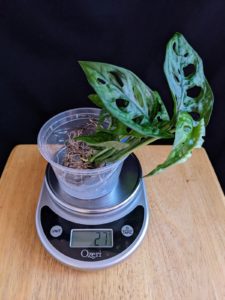
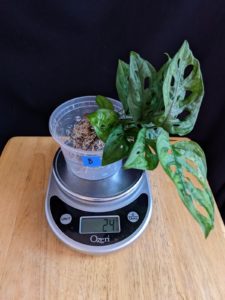
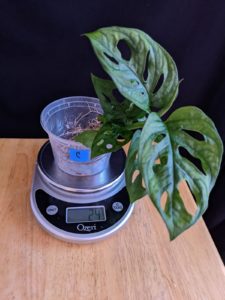
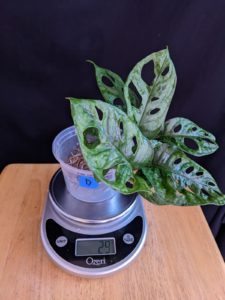
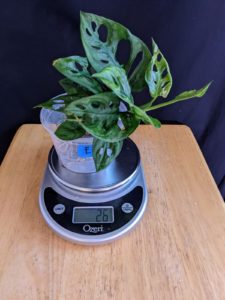
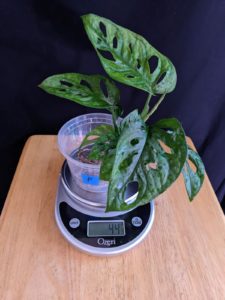
repotting
Potting Soil Mix—10 cups total
- 3 cups Miracle Grow potting mix
- 3 cups Miracle Grow succulent potting mix
- 1 cup leca
- 2 cups perlite
- 1 cup Better Gro orchid mix (pumice, wood chips, charcoal)
watering
- Every Monday, watered with fertilizer
- Placed plant in a plastic bowl
- Watered with one cup of fertilizer water
- Soaked for an hour
- Drained and placed back on the shelf
- During the week, whenever the top soil was dry the plants are watered with plain water and drained
humidity
Humidity monitor—Mini Indoor Thermometer Digital Hygrometer Room Thermometer Meter and Humidity Gauge with Temperature Humidity Monitor, Black.
The humidity was kept at “high.” When it went down the plants were misted with water or a humidifier was used.
A fan was used for air circulation to avoid mold growth.
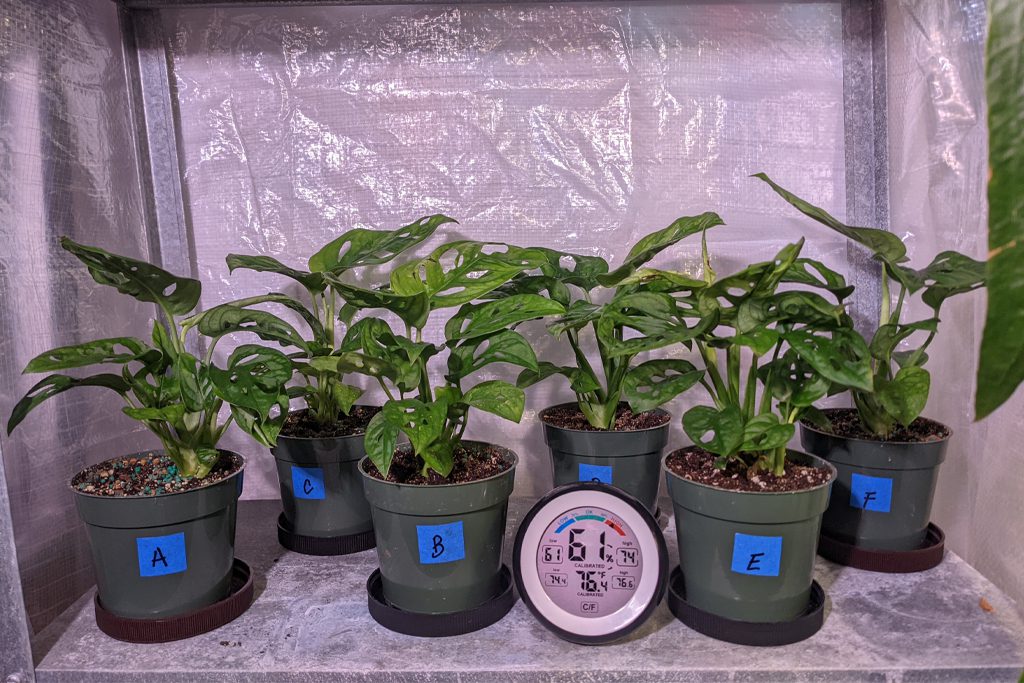
phase one—post-experiment updates
We measured the growth of the plant and checked the leaves to see if they grew in healthy.
January 15
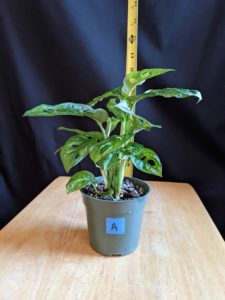
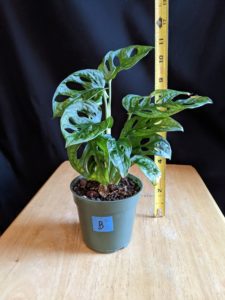
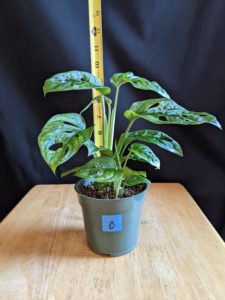
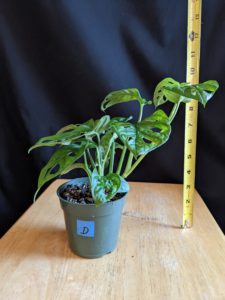
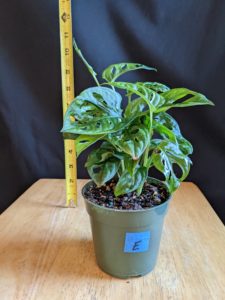
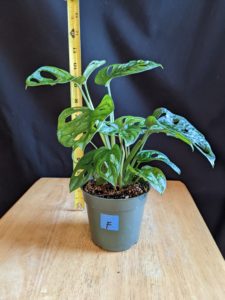
Observations:
One month into the experiment the plants have green leaves and new growth, most had two new leaves.
Feb 26
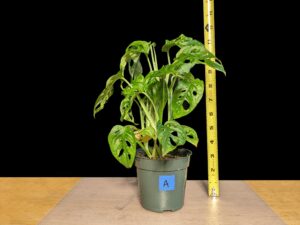
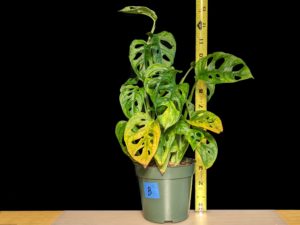
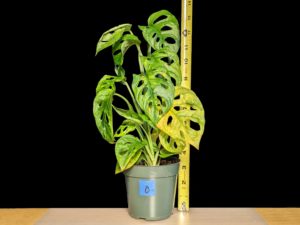
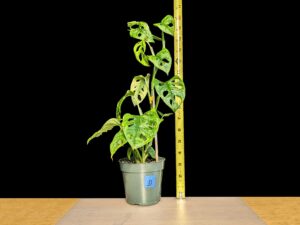
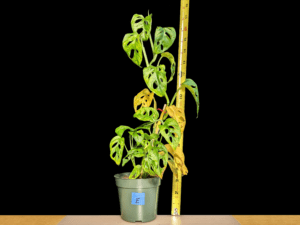
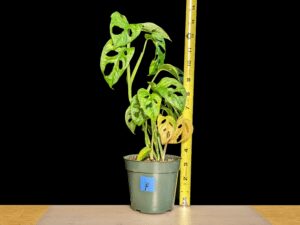
Observations:
- Plant A – two leaves on the bottom with yellow
- Plant B – three leaves on the bottom with yellow leaves and spots, vine/top leaves OK
- Plant C – two lower leaves yellow, two middle leaves with some yellow, vine/top leaves OK
- Plant D – two bottom leaves have yellow spots and brown spots, leaves on the vine have yellow spots
- Plant E – bottom leaves have yellow spots, the vine is leggy with small leaves and yellow leaves at the bottom
- Plant F – lower leaves are yellow, some of the leaves on the vine have faint yellow spots
Overall, the plants continued to grow. The new leaves were crinkled and pointing down. Some older leaves starting to show signs of chlorosis, with yellow leaves with dark green veins.
Weight (February 26)
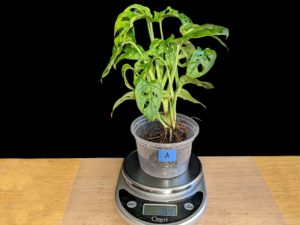
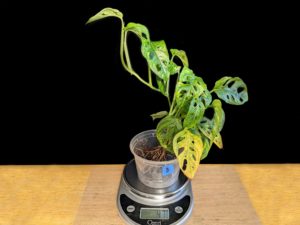
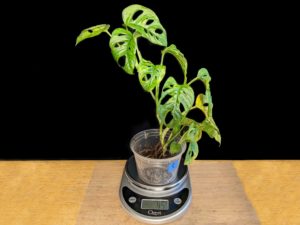
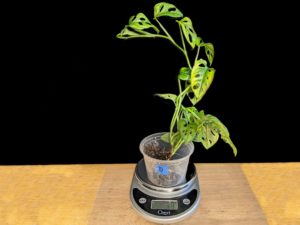
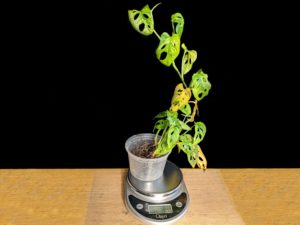
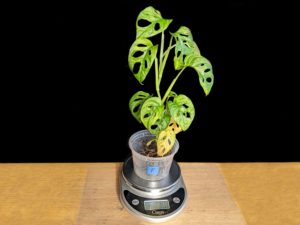
Observations:
All the fertilized plants grew in weight, the plant root mass grew and the roots were healthy.
- A – Liqui-Dirt – increased by 17 grams
- B – Easy Peasy liquid plant food – increased by 19 grams
- C – Purived liquid fertilizer for indoor plants – increased by 21 grams
- D – The Grow Co Organic indoor plant food – increased by 10 grams
- E – Superthrive – increased by 13 grams
- F – Control – decreased by 6 grams
phase two—recovery
Since the plants were experiencing fertilizer burn and chlorosis, we decided to see how long it would take for them to recover. The vines of Plants B, C, D, E, F, were trimmed and fertilizing was stopped. For the next month or so it was just watered with plain water.
February 26
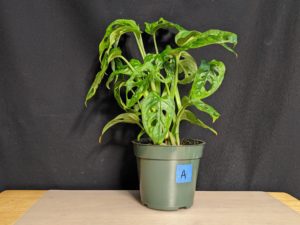
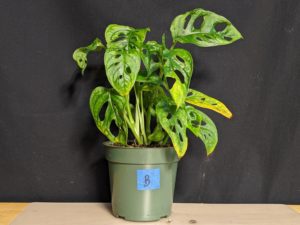
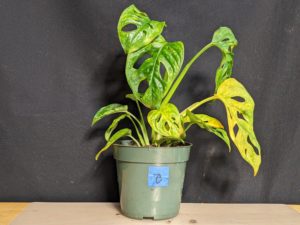
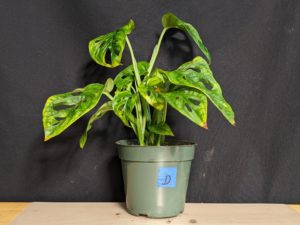
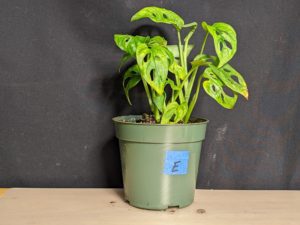
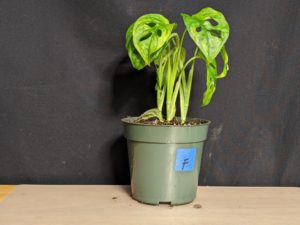
Observations:
The plants continued to show signs of overfertilization and dropped lower leaves.
April 16
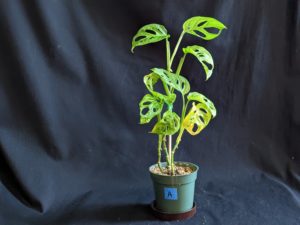
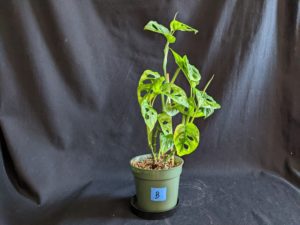
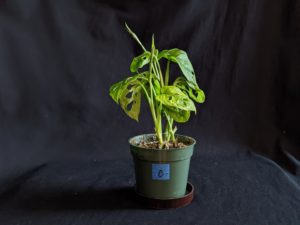
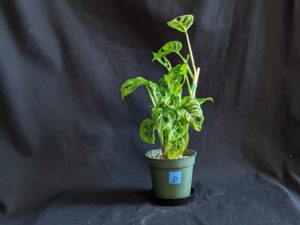
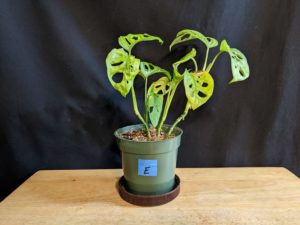
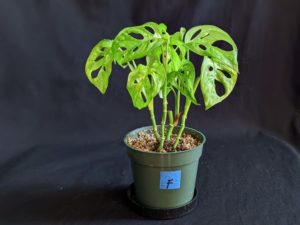
Observations:
After two months, the plants grew slowly and continued to lose lower leaves. But the new leaves grew outward (instead of downward) and were not crinkled.
Plant A – Liqui-Dirt
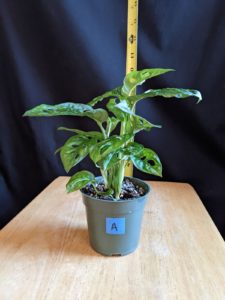

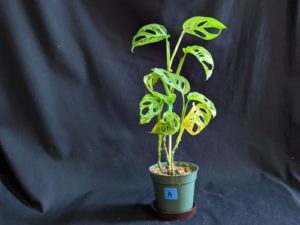
NPK ratio – none
Plant A had big green leaves but the vine didn’t grow that fast. It also ended up losing a lot of leaves in the end. A bunch of leaves had fertilizer burn and chlorosis.
After a trim and no fertilizer, two months later the new leaves look healthy.
B – Easy Peasy liquid plant food
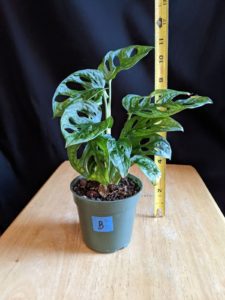
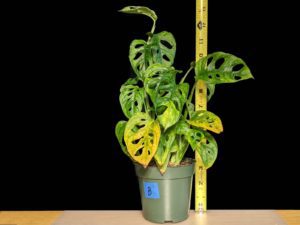
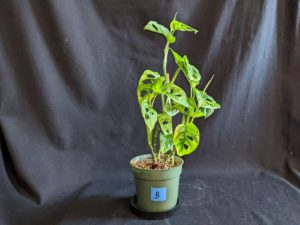
NPK ratio – 4-2-4
Plant B grew but not as much or fast as Plant C. It also lost fewer leaves than Plant C. Easy Peasy liquid plant food seemed to be gentle and the plant grew but not crazy fast or big. After two months the new leaves look healthy.
After a trim and no fertilizer, two months later the new leaves look healthy.
C – Purived liquid fertilizer for indoor plants
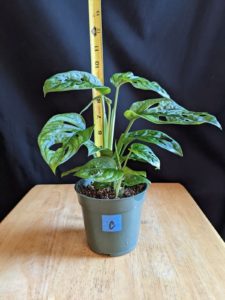
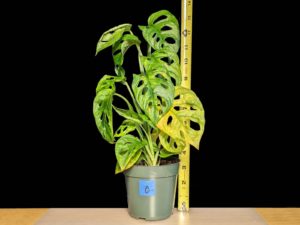
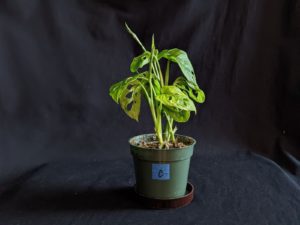
NPK ratio – 4-5-5
Plant C grew well and the leaves were big, but were pointing downward and crinkled. So for big leaves and fast growth Purived liquid fertilizer for indoor plants would be good to use but do not use it every watering to avoid overfertilization.
After a trim and no fertilizer, two months later the new leaves look healthy.
D – The Grow Co Organic indoor plant food
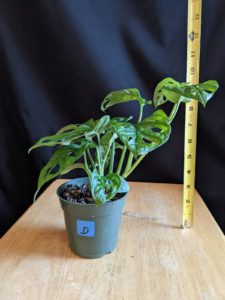

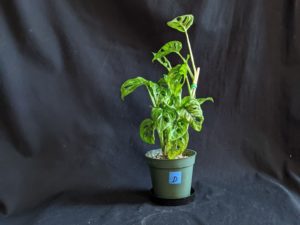
NPK ratio – 1-1-1
Plant D was leggy and the leaves grew in small and crinkled. Even though The Grow Co Organic indoor plant food has a low N-P-K ratio it still shouldn’t be used every watering. After two months the new leaves look healthy.
After a trim and no fertilizer, two months later the new leaves look healthy.
E – Superthrive
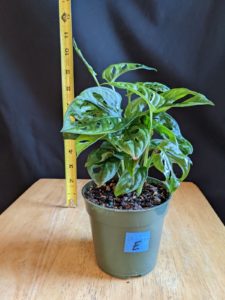

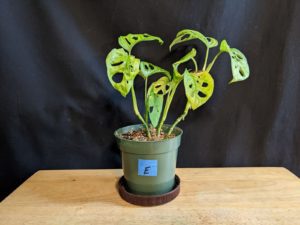
NPK ratio – 0.5-0-0
Plant E was leggy and the leaves grew in crinkled. Superthrive only has nitrogen and even in the small amount, it didn’t work well to be used every watering. The manufacturer also recommends using it in addition to other fertilizers and not just on its own.
After a trim and no fertilizer, two months later the new leaves look healthy. Some of the old leaves are still experiencing fertilizer burn.
F – plain water
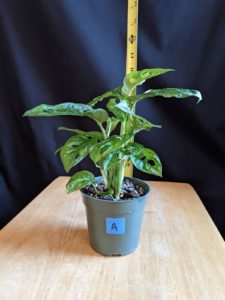

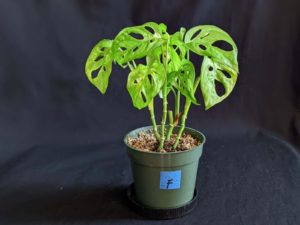
Plant F grew, but not as fast as the fertilized plants. It also lost its lower leaves.
After a trim and no fertilizer, two months later the new leaves look healthy.
recommendations
It is important to keep in mind the N-P-K ratio of the plant fertilizers. Each plant nutrient—nitrogen (N), phosphorus (P) and potassium (K)—has its own function to keep plants healthy.
Although the plants did grow with multiple leaves coming in and notable root growth, the leaves were not healthy. A lot of the older leaves died and the leaves crinkled and turned downward. The plants did not look happy!
We learned a lot from this indoor plant fertilizer experiment and it is good to know that it is not a good idea to use liquid fertilizers every time you water. Once a month is best to avoid over-fertilization. Also, please keep in mind that this is for potted indoor plants in soil only.
Hopefully, this post will help you decide which fertilizer to use!
More about fertilizing
- 10 Best Worm Composter Bins For Easy Homemade Compost
- Compost Starter 101: When You Need It And How To Make It
- Our top pothos fertilizer picks for luscious vines
- 5 reasons to use coffee as fertilizer for your plants
- Best fertilizer for Monstera plants for gorgeous leaves
- Fertilizer Burn on Plants? Here’s How to Fix it
- Fiddle leaf fig fertilizer: How to feed your fiddle leaf
- Tags:
- fertilizers
- Fertilizing

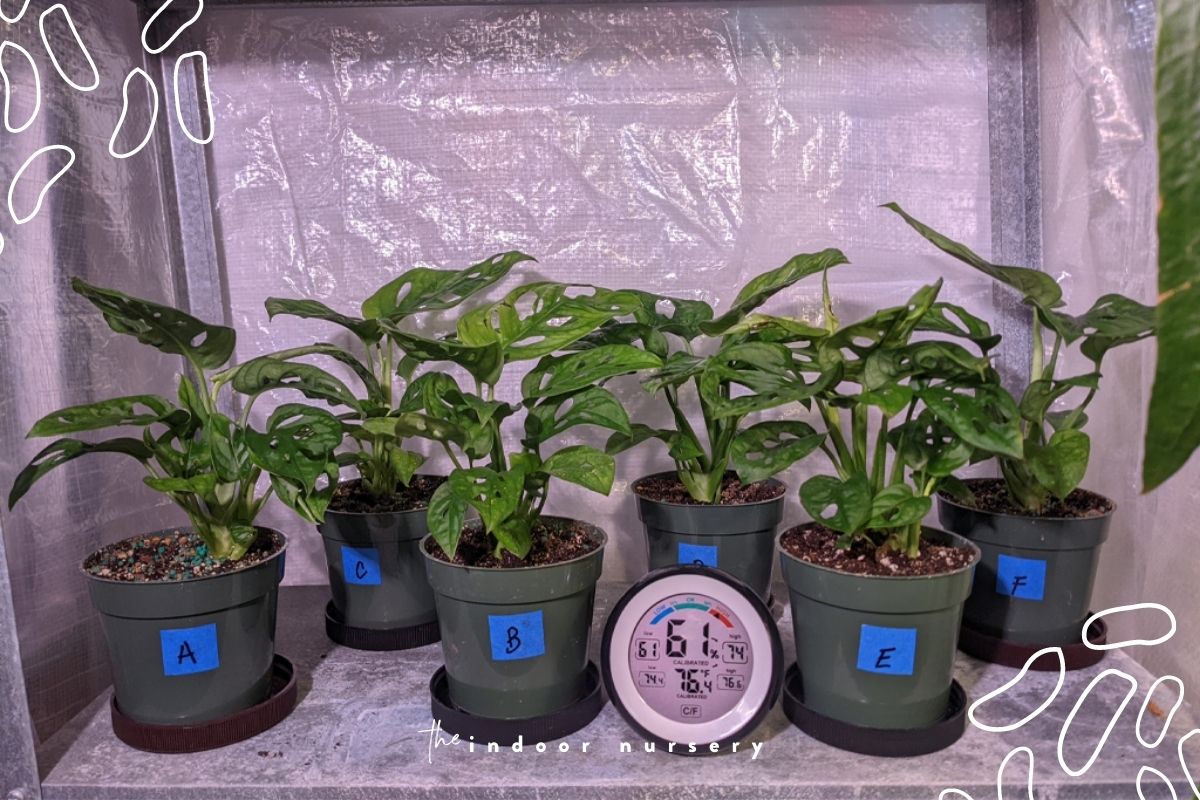
Thanks for such amazing explanation… l have learned a lot from this article.
Thank you, Sonia. I’m glad you found it so helpful.